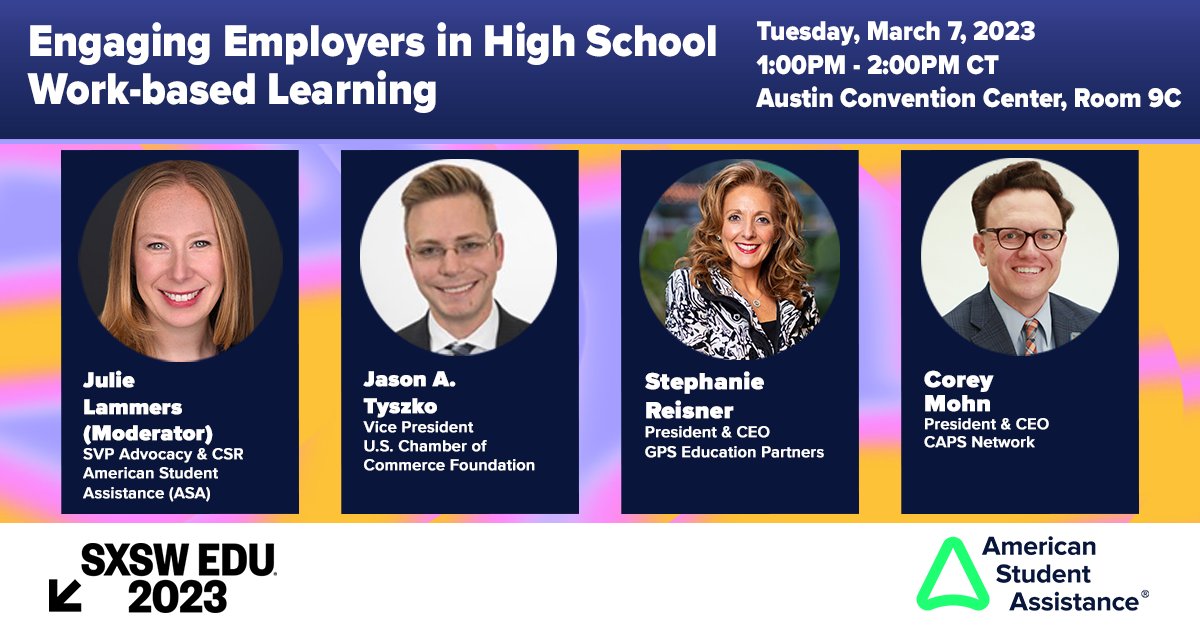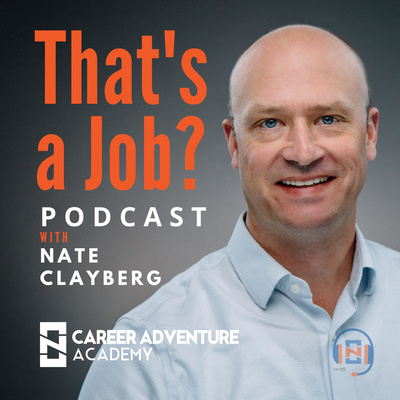By Julie Lammers, Senior Vice President, Advocacy and Corporate Social Responsibility at American Student Assistance

Each year, SXSW EDU brings together many of the most influential and forward-thinking professionals working in and around U.S. education. This year, I had the chance to moderate a panel discussion with a few such experts: Jason Tyszko, Vice President of the Center for Education and Workforce at the U.S. Chamber of Commerce Foundation; Stephanie Reisner, President and CEO of GPS Education Partners; and Corey Mohn, President of the CAPS Network. The topic? Finding better ways to engage employers to help high schoolers get a head start on exploring careers and learning more about what they do and don’t like. Why? Because the reality today is that while 79% of high schoolers are interested in a work-based learning experience, only around 34% of them knew of any such available opportunity. And only 2% have participated in one. Beyond that, many employers would benefit from creating a work-based program, but they simply don’t know where to begin.
There’s much work to be done in this space. That reality was not lost on these panelists, all of whom are deeply committed to creating better and smarter pathways for more kids.
Here are two main takeaways from our panel:
1. Businesses typically want to be part of the solution. Many need help getting started and help removing barriers.
Businesses have typically thought – as one might expect – primarily about the running of their business and haven’t had to invest quite so much energy into thinking about how and where they source talent. However, that’s changing rapidly as traditional talent pools dry up, leading employers to start thinking about skilling and hiring people differently.
Stephanie, a self-professed “recovering HR professional” explained that in her former role, “We ended up understanding that – as young people were coming to our doorstep ill-prepared for work and without the skills they needed – we had a responsibility as an employer to be able to say, ‘Okay – now we have to be a part of the solution, not just whining about the problem.’ So in 2000 we started to do something about it.”
Even for those employers who want to be part of the solution, work-based learning programs for kids often seem daunting to launch. But, when you sit down with business leaders, you also realize many of them are parents, former teachers, and connected in other ways to young people. Helping kids prepare for adult life is a cause most people intrinsically care about, because it’s in all of our best interests, but it’s also undeniably good for business.
What do employers really need in order to get moving and get involved in career exploration solutions and work-based learning for kids? They often need – as Jason pointed out – to understand what an education-employer partnership can look like in terms of value and return-on-investment. Often, that return is unexpectedly high.
“I’ve had HR come and say to me, ‘There would be mutiny right now if we took this program out of our shop floor, because these 30-year [workforce] veterans have “adopted” these students.’ They now understand that they’re transferring knowledge to these young people…and these are real jobs. These students are adding real value to the point that when one student was in the workplace for less than six months, they became a leader and were training other people.”
Corey added that offering a menu of experiences and types of engagements can ease some of the perceived burden of connecting with kids in an industry partnership. “It might be that [an employer] can serve as a mentor and start with one day a month, and others will want to get to a level of depth right out of the gate with an internship or apprenticeship.”
So, building and demonstrating value is a big part of the equation. However, we also discussed that, even when an employer does see that value and understand how such partnerships can help their talent supply while also helping them do good, they need the ability to scale the model and build capacity so it can work time and time again. A defining measure of success, Jason explained from his organization’s perspective, would be the ability to rapidly scale to having 100 business associations offering 10 or more work-based challenges per year and reaching 10,000 students with quality programming.
2. Work-based learning opportunities with employers can and should be high quality, practical and meaningful.
Kids who show up for work-based learning opportunities in partnership with employers are empowered to feel – and work – as real professionals do. They’re given a safe place in which to experiment, learn, fail, succeed, and decide whether this line of work is something worth pursuing in the long haul. But the value of that experience shouldn’t only be intangible. Kids going through these programs can and do build useful social capital in the form of a network of professionals who know them and are willing to vouch for their ability and competency. They often receive mentorship and that can be worth its weight in gold. A high-quality program also may yield a credential that is stackable and transferable to wherever a kid ends up next.
“We all know that the high-quality project-based learning experience will be authentically employer-led…but we want to make sure that learners with those experiences are credentialed in a way that has currency in today’s labor market,” Jason shared.
Sometimes, the value for participating students comes in unexpected ways. Corey shared an anecdote of an entrepreneurial challenge in which kids spent days working to solve a complex problem.
“When the event finished, an entrepreneur came up and said, “I need the names of the students that pitched to me, because I’m going to write a white paper about the insights and I want them to be listed as the ones who provided the input.”
The great news? All of our panelists are actively working to ensure that more employers have both the resources and the knowledge to make work-based learning opportunities a more permanent part of the professional landscape. Stephanie summed it up perfectly: “ All of the folks on this panel today have come together to make sure we’re connecting the dots for educators, for employers, and for entire communities because we know this work gets executed at the local level, but we need to scale it nationally. And we’re here to help!”
The net takeaway? A strong partnership is about shared value.
From this conversation, I hope you take away one resounding point: any industry-aligned, workforce-based learning experience – no matter where it’s located and no matter what shape it takes on – needs to offer genuine, shared value for kids, employers and the broader community. When kids benefit from the experience of “trying on” a career, so, too, does the industry partner. And the ripple effect of opportunity and learning continues.
If you’d like to watch the full recording of my panel conversation with Stephanie, Jason, and Corey, you can find it here. For more on youth career readiness, please review and subscribe to our thought leadership newsletter, PivotED.


